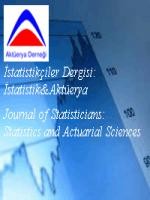Öz Bağlanım Denklem Tahmini ile Durağanlık Testi: Bir Endüstriyel İşletişim Örneği
AR ve ARMA tahminleri, eldeki bir seri için temel bir matematiksel ifadeyi belirlemek açısından iyi bilinen araçlar olmaya devam etmektedir. Matematiksel bir denklem elde edildiğinde, girdi ve çıktı arasında bir transfer fonksiyonu türetmek mümkündür. Bu transfer fonksiyonunun kutupları birim çemberin üzerinde veya dışında yer alıyorsa, üretilen seri durağan olmayacaktır. Önemli sayıda numunenin üretildiği böyle bir seri, bir simülasyon etkinliği için tamsayı taşmalarına neden olacaktır. Çalışma için, Hatalar Arası Ortlama Zaman (HAOZ) gözlem amaçlı doğrulama serisi, bir Endüstriyel Gömülü PC İletişimi Sınama yatağından alınmıştır. Bunlar zaman ve sıklık açısından AR ve ARMA tarafından tahmin edilenlerle karşılaştırılır. AR tahmini, durağan özelliği koruyan 57 derecelik bir polinom durumunda, orijinal gözlemle daha iyi bir eşleşmeye sahiptir.
Anahtar Kelimeler:
Öz Bağlanım (AR), Hareketli Ortalama (MA), Öz bağlanım hareketli ortalama (ARMA), Cisimlerin Interneti (IoT), eşvaryans, varyans değişkenliği, durağanlık, HAOZ, Auto-Regression (AR), Moving Average (MA), Auto Regression Moving Average (ARMA), Internet of Things (IoT), Homoscedasticity, Heteroscedasticity, stationarity, MTBF.
Stationarity test by auto-regression equation estimation: an industrial workshop communication example
The AR and ARMA estimations remain well-known tools for determining an underlying mathematical expression for a series at hand. Once a mathematical equation is obtained, it is possible to derive a transfer function between the input and output. If the poles of this transfer function reside on or outside the unit circle, the series generated would not be stationary. Such a series with a significant number of samples generated would cause integer overflows for a simulation activity. For the study, the MTBF observation purposed validation series is considered from an Industrial Embedded PC Communications Test-Bed. These are compared on time and frequency to AR and ARMA estimated ones. The AR estimation possesses a better match to the original, with a 57-degree polynomial maintaining the stationary property.
Keywords:
Auto-Regression (AR), Moving Average (MA), Auto Regression Moving Average (ARMA), Internet of Things (IoT), Homoscedasticity, Heteroscedasticity, stationarity, MTBF.,
___
- [1] O. Yucesan , A. Ozkil ve E. Ozbek , “A Reliability Assessment of an Industrial Communication Protocol on a Windows OS Embedded PC for an Oil Rig Control Application” in Journal of Science, Technology and Engineering Research, c. 2, volume. 2, pages. 22-30, Dec. 2021, doi:10.53525/jster.971534
- [2] O. Yucesan , A. ̈Ozkil ve M. E. ̈Ozbek , “Validity of Exponential Distribution for Modelling Inter-failure Arrival Times of Windows-based Industrial Process Control Data Exchange” in Journal of Science, Technology and Engineering Research, c. 3, Volum. 1, pages. 1-8, June. 2022,, doi:10.53525/jster.1017004
- [3] U. Barman, R. D. Choudhury, A. Ekbal Hussain, M. J. Dahal, P. Barman, and M. Hazarika, “Comparative Assessment of AR, MA, and ARMA for the Time Series Forecasting of Assam and Megha- laya Rainfall Division,” 2020 International Conference on Computational Performance Evaluation (ComPE), 2020, pp. 507-511, DOI: 10.1109/ComPE49325.2020.9200014.
- [4] Worden, K., Iakovidis, I., Cross, E.J. (2019). “On Stationarity and the Interpretation of the ADF Statistic”. In Pakzad, S. (eds) Dynamics of Civil Structures, Volume 2. Conference Proceedings of the Society for Experimental Mechanics Series. Springer, Cham. https://doi.org/10.1007/978-3-319-74421-6 50
- [5] Muhei-Aldin O, VanSwearingen J, Karim H, Huppert T, Sparto PJ, Erickson KI, Sejdi ́c E. “An investigation of fMRI time series stationarity during motor sequence learning foot tapping tasks.” in J. Neurosci Methods, 2014 Apr 30;227:75-82. doi: 10.1016/j.jneumeth.2014.02.003. Epub 2014 Feb 11. PMID: 24530436; PMCID: PMC3987746.
- ISSN: 1308-0539
- Yayın Aralığı: Yılda 2 Sayı
- Başlangıç: 2008
- Yayıncı: Aktüerya Derneği
